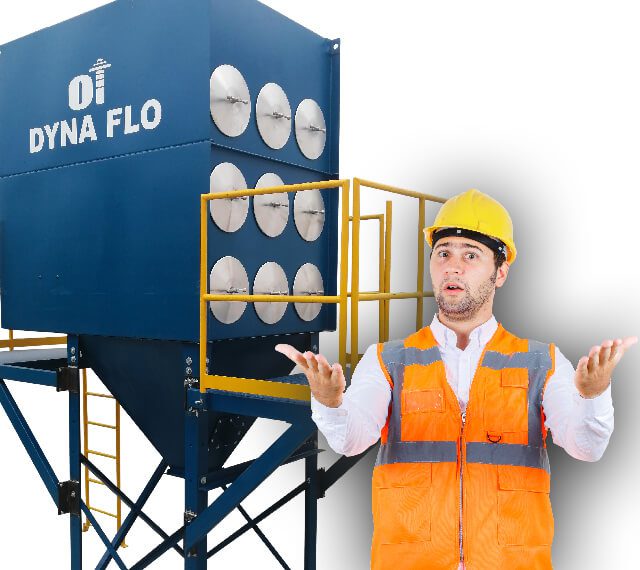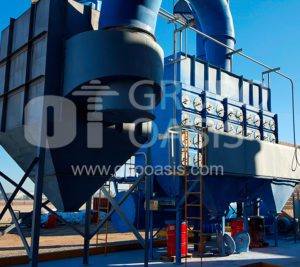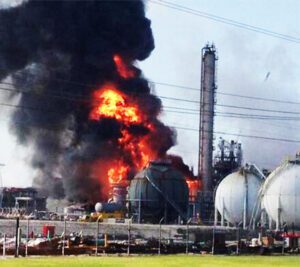Dust Collectors

BLOG
Frequently Asked Questions about Dust Collectors
In order to control dusts, fumes, mists or gases, the industry must have specialized systems or they must invest in them. These systems force various questions to be asked, since some of these can be very simple or very complex. Some frequently asked questions are ...
1. What type of dust collector do I need for my application
Typically most industrial dust collectors are bag / sleeve or cartridge type, however, they are not the best solution in all cases.
a) Baghouse: These equipments, also known as the Filter Drawer, are ideal for dry dust collection applications, they are highly efficient and capture submicron particles. Not recommended for wet or sticky applications. High concentrations of dust can cause operational problems.
Cyclonic pre-filter systems can help improve Baghouse performance during operation.
b) Cartridge collectors: This system is less expensive than a Baghouse, the cartridge collectors are less tolerant than a Baghouse in wet and sticky applications. The pleated filters allow greater air flow offering a larger filtration surface. Cartridge collectors have lower dust concentration thresholds than a Baghouse.
c) Cyclone collector These types of dust collectors are low maintenance and have high efficiency in removing dusts larger than 10 microns and larger. They also function many times as a pre-filter system for a baghouse or baghouse, cartridge collector or wet scrubber. They operate more efficiently with higher concentrations of dust.
d) Wet scrubber: can be applied for water soluble powders. These can also remove fumes (acids, bases, amines, etc.) from the air stream. They are very efficient, but require special treatment, since the waste can contaminate the water.
e) Electrostatic precipitators: They have a very high efficiency dust removal ability, the size of the particles is not that important. They are very effective with submicron particles, but they need to have pre-filters.
f) Filter Collector: These are the most basic dust collectors. Its filters are disposable, they are effective with very low concentrations of particulate dust. Filters are replaced every time they are clogged. Cyclonic pre-filters can be used to increase filter life.
2. What information do I need to determine the size of my dust collector?
You must provide all the information that is necessary, with it they will be able to initially have the data so that the dust collector is dimensioned.
Some of the basic questions are:
a) What is the air flow through the dust collector?
b) What is the temperature and pressure that the dust collector must withstand?
c) What type of dust, smoke, mist or gas is being collected?
d) Is it explosive or abrasive?
e) What removal efficiency do you need?
The five questions above will allow the supplier to get a general idea of the type of equipment you require and provide you with a quote. However, with the above information alone, the performance of the dust collector cannot be guaranteed as this requires a series of calculations and site visits to be more accurate.
3. Is my powder explosive?
To help answer this question, the NFPA (National Fire Protection Association) in the United States, has published two standards NFPA-652 and NFPA-654, which establish the characteristics that powders must meet to be considered explosives. A combustible dust is defined as a fuel finely divided into solid particles that present a risk of explosion or sudden fire when it is suspended in the air or the specific oxidizing medium of the process over a range of concentrations. Basically what this means is when there is dust in the air and its concentration is sufficient to cause a fire, spread a deflagration or explosion if exposed to a spark, then it is considered combustible. If you are not sure that your dust is not combustible, you should send the dust sample to a laboratory for analysis. The laboratory should provide one of three responses: no reaction, combustible but no propagator, or propagator.
Typically, the lab will initially do a pass or no pass test. If the dust shows no signs of burning, the test will stop. If it shows signs of combustion, they will do further testing and provide the explosion properties (K st and P max) of the dust. The K st tells you how fast the blast will propagate, while P max tells you the force of the blast.
Some things to remember:
- Combustible dust mixed with non-combustible dust may not pass the test; so if you have both in a mix, give it a try.
- Material that may not burn can still be combustible as dust; Unless you are sure, you will need to take a test to be sure.
- If you have made a process change that changes the composition, relative concentrations, etc., of the powder, then the combustibility of the powder may have changed and a retest should be performed.
- If you have combustible dust in your facility, then it is a hazard. The analysis of the entire area must be carried out at most every five years.
4. Can I increase the air flow through my dust collector?
Before you can answer this, you will need to review your dust collector system, when properly designed by specialized personnel, they provide the best performance you need. If one part of the system fails or is undersized, the whole system will fail. The following are brief descriptions of each part of the system and how changing airflow affects them.
Hoods / Suction points
The hoods are used to function as a dust collection point, they are designed to provide a specific air flow at a minimum speed. Hood type, location, and quantity are often specific. The industrial ventilation manual provides guidelines for speed ranges this to provide adequate ventilation.
A lower speed than suggested could cause dust to escape from the hood. Adding additional hoods to an existing system could cause the airflow (and suction speed) to drop below the suggested minimum, thus making a noticeable reduction in performance.
Ducts / ducts
The duct / duct network of a properly designed ventilation system must be dimensioned so that it has the lowest possible pressure drop and has a minimum speed to keep the pressure low, it is desirable to keep the duct network as straight as possible, minimize the turns and keep the duct size larger. Since we are moving dust, you must also make sure to keep a minimum speed, or the dust could settle in straight sections. This will cause increased resistance and could create a fire or explosion hazard. Generally, it is desirable to keep the air speed above 4,000 FPM to avoid dust accumulation. Also meeting the standard duct / duct size will keep costs low.
Dust Collector
Some dust collectors are less sensitive to added airflow than others. The pressure drop of a cyclone will increase as the air flow through it increases. On the other hand, in a filter collector the efficiency will decrease if the air flow is increased too much. A wood dust cartridge collector could handle higher airflows than silica dust. If you want to make any adjustments to the dust collector, it is best to contact the manufacturer.
Fan
The fan is the most important piece of equipment in a dust collection system. This provides the driving force to collect the air and dust mixture. Many times people will add extra suction points and not change or adjust the fan; therefore, the capacity is reduced and less air will be drawn from each existing suction point. When looking to increase airflow in a dust collection system, be sure to calculate the total required airflow and static pressure. Then check if the existing fan can handle it (open gates, speed up), and if not, then a new fan will be required.
5. I replaced my filter drawer with a cartridge type collector and it doesn't work very well, why?
Today, cartridge type collectors are used instead of filter drawers in many dust collection applications. Some advantages are: smaller cartridge, lower filter cost, easy maintenance, and lower maintenance cost. However, not all applications are suitable for a cartridge type collector. Some of the differences between the filter drawer and the cartridge collector are the filters. A cartridge collector uses a pleated filter, this allows the filter a greater surface area in a given diameter, this allows a greater flow of air through the filter, unlike a simple bag type. However, this is usually the main cause of cartridge collector failure, when the filter drawer would not. Pleated filters are easier to cover than a bag. If you start to fill in your pleats, the available surface area of the filter drops off quickly. This increases your pressure drop, thereby decreasing the airflow in your system. High concentrations of dust, wet and sticky powders and hygroscopic all these factors can cause the pleats to clog, this will cause a high maintenance cost for the cartridge collector. Bags, on the other hand, generally don't use pleats. Therefore, the surface area is strictly the surface area of the cylindrical bag (supported by a basket). When dust begins to accumulate in the bag, the surface area is not restricted as much as in a pleated filter, so the pressure drop does not increase as quickly. Also, with sticky powders, the dust only has one point of contact with one filter, as opposed to a pleated filter where it can have two. Having a single point will facilitate eviction during cleanup. The other difference between the filter drawer and the cartridge collector is maintenance. A cartridge filter is a complete filter with a holder, when it needs to be replaced, then everything is replaced in an hour. Cartridge collectors typically have cartridges mounted horizontally and easily accessible from the side. This ease of side access reduces replacement times.
A filter drawer generally has the bags hanging from a plate and requires venturi (for compressed air), baskets and bags. To replace a bag, the bag, basket and venturi (sometimes requires entering confined spaces), box, and then venturi must be removed before the bag can be replaced. All of this takes much longer than a cartridge unit. The problem is that cartridge type units have horizontal filters, often the upper parts of the filters are not cleaned as well as the rest of the filters, this can clog the filter on its surface, so this will cause the increase of the filter. pressure drop across filter. Since the bags are generally vertical, all sides of the bags are cleaned equally, providing a uniform filter load. Again, high loads of dusty, wet and sticky, hygroscopic powders can contribute to this problem. The last difference between the collectors is the filter material; cartridge filters are made of different types of fabrics. They often use plastic, glue, or lightweight metal in their construction. This keeps the maximum temperature low. A bag, however, can be made from virtually any fabric, the separate venturi and basket also provide greater flexibility for temperatures.
If you have a cartridge type collector, which is having problems as described above, don't worry. You may not have to replace it with a filter drawer. Often times a cyclone prefilter will solve the above problems. The pre-filter will reduce the dust load on the cartridge collector. This will increase the time it takes to plug the filters and make cleaning easier. A cyclone pre-filter could also provide more time for the airflow to cool down, thus lowering the temperature in the cartridge manifold.
Source: Aerodyne
Dust Collectors
Dust Collectors
Dust Collectors / Colectores de Polvos / Colectores de Polvos
Other articles of interest

Airborne particles What are they?
Pollutants in the atmosphere are more common than we all think, they directly impact the environment and health. Suspended particles as it is commonly known...

Definition of air flow
It is the movement of air between two points, as a result of a pressure difference between them, with the direction of flow always being from the point of higher to lower pressure...

Explosive Atmosphere and Ventilation Systems
During the various production processes, there are some materials that can create an explosive atmosphere and therefore high risk if proper handling and control of them is not carried out, since these…






